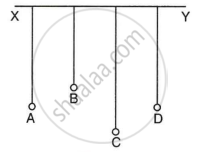Advertisements
Advertisements
Question
Solution
When an oscillatory system is made to oscillate under the action of an externally applied periodic force, it is said to execute forced vibrations. In this case the external frequency may or may not be equal to the natural frequency of the body.
In case of resonance, the externally applied periodic force has the same frequency as the natural frequency of oscillation of the given oscillatory system.
APPEARS IN
RELATED QUESTIONS
Distinguish between the free (or natural) and forced vibrations.
Give one example to illustrate forced vibrations.
Describe a simple experiment to illustrate the phenomenon of resonance and explain it.
Resonance is a special case of ______ vibrations, when frequency of the driving force is ______ natural frequency of the body.
Differentiate between the forced and resonant vibrations.
In following figure shows A, B, C and D are four pendulums suspended from the same elastic string XY. Lengths of pendulum A and D are equal, while the length of pendulum B is smaller and the pendulum C is longer. The pendulum A is set into vibration.
(a) what is your observation? (b) Give reason for your observation.

In Fig. A, B, C and D are four pendulums suspended from the same elastic string XY. The lengths of pendulum A and D are equal, while the length of pendulum B is shorter and of the pendulum C is longer. Pendulum A is set into vibrations.

- What is your observation about the vibrations of pendulum D?
- Give reason for your observation in part (a).
- What type of vibrations take place in pendulums Band C?
- Give reason for the answer in part (c).
Differentiate between the following:
Free and forced vibrations.
When acoustic resonance takes place, a loud sound is heard. Why does this happen? Explain.
What do you understand by forced vibrations?
